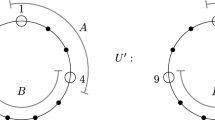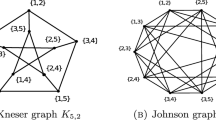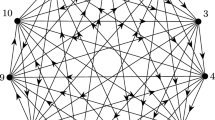Abstract
We study the chromatic symmetric functions of graph classes related to spiders, namely generalized spider graphs (line graphs of spiders), and what we call horseshoe crab graphs. We show that no two generalized spiders have the same chromatic symmetric function, thereby extending the work of Martin, Morin and Wagner. Additionally, we establish Query ID="Q3" Text="Please confirm if the inserted city name in affiliation [3] is correct. Amend if necessary." that a subclass of generalized spiders, which we call generalized nets, has no e-positive members, providing a more general counterexample to the necessity of the claw-free condition. We use yet another class of generalized spiders to construct a counterexample to a problem involving the e-positivity of claw-free, \(P_4\)-sparse graphs, showing that Tsujie’s result on the e-positivity of claw-free, \(P_4\)-free graphs cannot be extended to graphs in this set. Finally, we investigate the e-positivity of another type of graphs, the horseshoe crab graphs (a class of unit interval graphs), and prove the positivity of all but one of the coefficients. This has close connections to the work of Gebhard and Sagan and Cho and Huh.














Similar content being viewed by others
References
Brandstädt, A., Mosca, R.: On variations of \(P_4\)-sparse graphs. Disc. Appl. Math. 129, 521–532 (2003)
Brosnan, P., Chow, T.: Unit interval orders and the dot action on the cohomology of regular semisimple hessenberg varieties. Adv. Math. 329, 955–1001 (2018)
S. Cho and J. Hong, Positivity of chromatic symmetric functions asssociated with Hessenberg functions of bounce number 3, arXiv:1901.07308, (2019)
Cho, S., Huh, J.: On \(e\)-positivity and \(e\)-unimodality of chromatic quasisymmetric functions. SIAM J. Discrete Math. 33, 2286–2315 (2019)
Dahlberg, S., van Willigenburg, S.: Lollipop and lariat symmetric functions. SIAM J. Discrete Math. 33, 1029–1039 (2018)
S. Dahlberg, A. Foley and S. van Willigenburg. Resolving Stanley’s \(e\)-positivity of claw-contractible-free graphs, J. Eur. Math. Soc. (JEMS) 22, 2673–2696 (2020)
Gasharov, V.: Incomparability graphs of (3+1)-free posets are \(s\)-positive. Discrete Math. 157, 193–197 (1996)
Gebhard, D., Sagan, B.: A chromatic symmetric function in noncommunting variables. J. Algebraic Combinatorics 13, 227–255 (2001)
Giakoumakis, V., Vanherpe, J.-M.: On extended \(P_4\)-reducible and extended \(P_4\)-sparse graphs. Theoret. Computer Sci. 180, 269–286 (1997)
Godsil, C.D.: Algebraic Combinatorics. Chapman and Hall Inc., New York (1993)
M. Guay-Paquet. A modular relation for the chromatic symmetric function of (3+1)-free posets, arXiv:1306.2400 , (2013)
M. Guay-Paquet. A second proof of the Shareshian–Wachs conjecture, by way of a new Hopf algebra, arXiv:1601.05498, (2016)
Harada, M., Precup, M.: The cohomology of abelian Hessenberg varieties and the Stanley-Stembridge conjecture. Algebraic Combinatorics 2, 1059–1108 (2019)
C.T. Hoàng, A class of perfect graphs, Master’s Thesis, School of Computer Science, McGill University, Montréal, (1983)
Jamison, B., Olariu, S.: A tree representation for \(P_4\)-sparse graphs. Discrete Appl. Math. 35, 115–129 (1992)
Jamison, B., Olariu, S.: Recognizing \(P_4\)-sparse graphs in linear time. SIAM J. Comput. 21, 381–406 (1992)
Lepovic, M., Gutman, I.: No starlike trees are cospectral. Discrete Mathematics 242, 291–295 (2002)
MacDonald, I.G.: Symmetric Functions and Hall Polynomials, \(2^{nd}\) edition. Oxford University Press, Oxford (1995)
Martin, J., Morin, M., Wagner, J.: On distinguishing trees by their chromatic symmetric functions. J. Combinatorial Theory Ser. A 115, 237–253 (2008)
Orellana, R., Scott, G.: Graphs with equal chromatic symmetric functions. Discrete Math. 320, 1–14 (2014)
B. Pawlowski. Chromatic symmetric functions via the group algebra of \(S_n\), arXiv:1802.05470, (2018)
Sagan, B.: The Symmetric Group: Representations, Combinatorial Algorithms, and Symmetric Functions. Springer, Berlin (2001)
Shareshian, J., Wachs, M.: Chromatic quasisymmetric functions. Adv. Math. 295, 497–551 (2016)
Stanley, R.: A symmetric function generalization of the chromatic polynomial of a graph. Adv. Math. 111, 166–194 (1995)
Stanley, R.: Graph colorings and related symmetric functions: ideas and applications. Discrete Math. 193, 267–286 (1998)
Stanley, R., Stembridge, J.: On immanants of Jacobi-Trudi matrices and permutations with restricted position. J. Combinatorial Theory Ser. A 62, 261–279 (1993)
Tsujie, S.: The chromatic symmetric functions of trivially perfect graphs and cographs. Graphs and Combinatorics. (2017). https://doi.org/10.1007/s00373-018-1928-2
Acknowledgements
The authors thank Owen Merkel for suggesting the problem e-positivity of generalized nets, and Chính Hoàng for suggesting the problem of e-positivity of claw-free, \(P_4\)-sparse graphs. The authors also thank Leo Tenenbaum for providing code used towards this project. This work was supported by the Canadian Tri-Council Research Support Fund. The author A.M.F. was supported by an NSERC Discovery Grant. This research was conducted at the Fields Institute, Toronto, Canada as part of the 2018 Fields Undergraduate Summer Research Program and was funded by that program.
The authors thank the referees whose helpful suggestions have improved the paper.
Author information
Authors and Affiliations
Corresponding author
Additional information
Publisher's Note
Springer Nature remains neutral with regard to jurisdictional claims in published maps and institutional affiliations.
Rights and permissions
About this article
Cite this article
Foley, A.M., Kazdan, J., Kröll, L. et al. Spiders and their Kin: An Investigation of Stanley’s Chromatic Symmetric Function for Spiders and Related Graphs. Graphs and Combinatorics 37, 87–110 (2021). https://doi.org/10.1007/s00373-020-02230-4
Received:
Revised:
Accepted:
Published:
Issue Date:
DOI: https://doi.org/10.1007/s00373-020-02230-4




